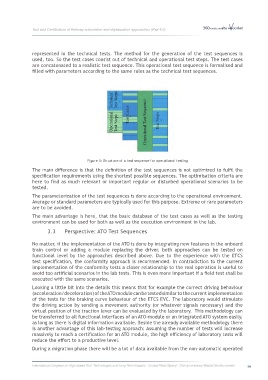Page 101 - 360.revista de Alta Velocidad - Nº 5
P. 101
Test and Certification of Railway automation and digitalization approaches (Rail 4.0)
represented in the technical tests. The method for the generation of the test sequences is
used, too. So the test cases consist out of technical and operational test steps. The test cases
are concatenated to a realistic test sequence. This operational test sequence is formalised and
filled with parameters according to the same rules as the technical test sequences.
Figure 4: Structure of a test sequence for operational testing
The main difference is that the definition of the test sequences is not optimized to fulfil the
specification requirements using the shortest possible sequences. The optimisation criteria are
here to find as much relevant or important regular or disturbed operational scenarios to be
tested.
The parameterization of the test sequences is done according to the operational environment.
Average or standard parameters are typically used for this purpose. Extreme or rare parameters
are to be avoided.
The main advantage is here, that the basic database of the test cases as well as the testing
environment can be used for both as well as the execution environment in the lab.
3.3 Perspective: ATO Test Sequences
No matter, if the implementation of the ATO is done by integrating new features in the onboard
train control or adding a module replacing the driver, both approaches can be tested on
functional level by the approaches described above. Due to the experience with the ETCS
test specification, the conformity approach is recommended. In contradiction to the current
implementation of the conformity tests a closer relationship to the real operation is useful to
avoid too artificial scenarios in the lab tests. This is even more important if a field test shall be
executed with the same scenarios.
Looking a little bit into the details this means that for example the correct driving behaviour
(acceleration/deceleration) of the ATO module can be tested similar to the current implementation
of the tests for the braking curve behaviour of the ETCS EVC. The laboratory would stimulate
the driving action by sending a movement authority (or whatever signals necessary) and the
virtual position of the traction lever can be evaluated by the laboratory. This methodology can
be transferred to all functional interfaces of an ATO-module or an integrated ATO system easily,
as long as there is digital information available. Beside the already available methodology there
is another advantage of this lab-testing approach: Assuming the number of tests will increase
massively to reach a certification for an ATO module, the high efficiency of laboratory tests will
reduce the effort to a productive level.
During a migration phase there will be a lot of data available from the non-automatic operated
International Congress on High-speed Rail: Technologies and Long Term Impacts - Ciudad Real (Spain) - 25th anniversary Madrid-Sevilla corridor 99

